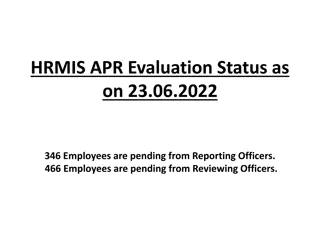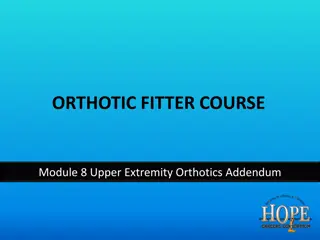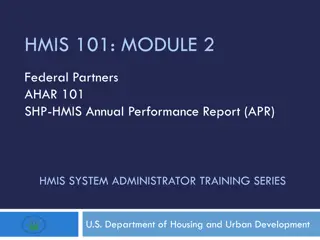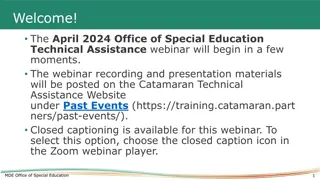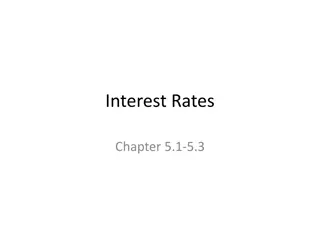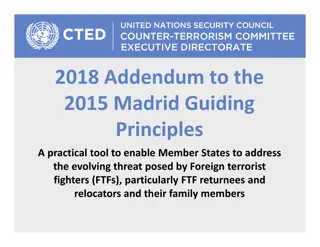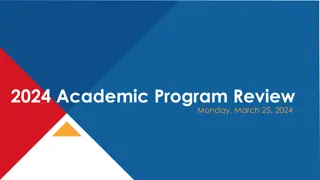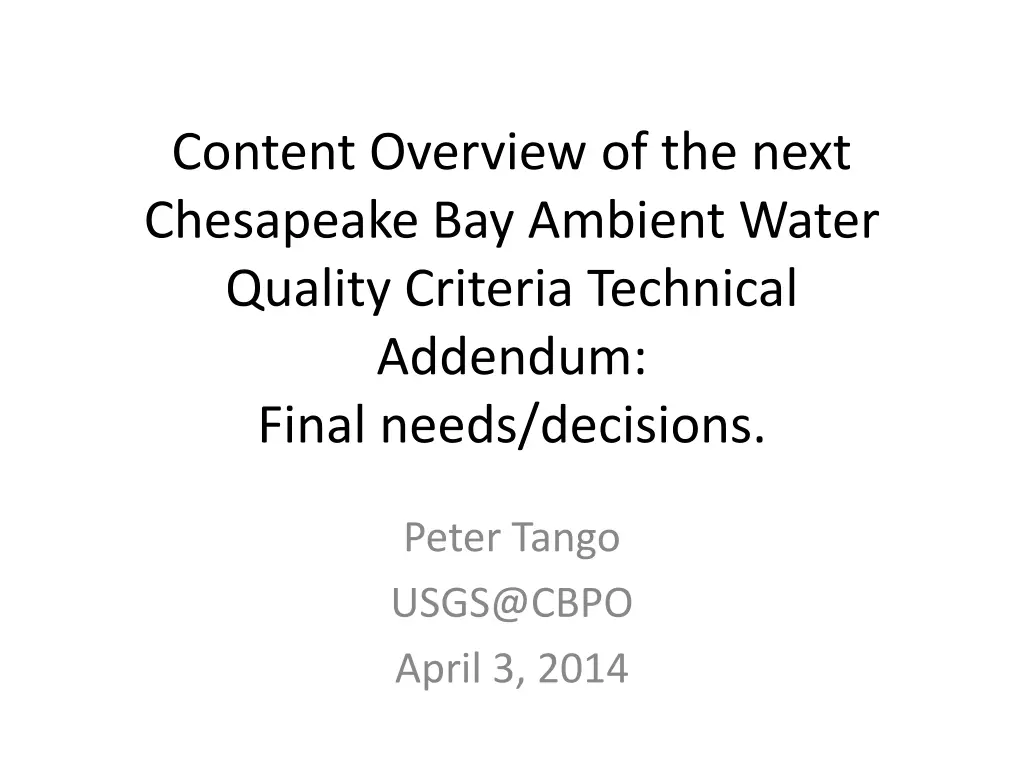
Chesapeake Bay Ambient Water Quality Criteria Technical Addendum Overview
Explore the detailed content overview of the next Chesapeake Bay Ambient Water Quality Criteria Technical Addendum, covering chapters relevant to assessment frameworks, criteria assessment protocols, Bay health tracking, and specific segments like the Western Branch Patuxent River and Open Water Designated Use. Dive deep into the development of new water quality standards and restoration goals for the Chesapeake Bay.
Download Presentation

Please find below an Image/Link to download the presentation.
The content on the website is provided AS IS for your information and personal use only. It may not be sold, licensed, or shared on other websites without obtaining consent from the author. If you encounter any issues during the download, it is possible that the publisher has removed the file from their server.
You are allowed to download the files provided on this website for personal or commercial use, subject to the condition that they are used lawfully. All files are the property of their respective owners.
The content on the website is provided AS IS for your information and personal use only. It may not be sold, licensed, or shared on other websites without obtaining consent from the author.
E N D
Presentation Transcript
Content Overview of the next Chesapeake Bay Ambient Water Quality Criteria Technical Addendum: Final needs/decisions. Peter Tango USGS@CBPO April 3, 2014
Chapters 1-3 Relevant to the Criteria Assessment Framework WBRTF bathymetry, volume developed Open Water Designated Use Definition Review SAV Goal Alignment
Chapters 4-6 Criteria Assessment Protocols DO: Focus on Short duration Criteria assessment options Interim rules for 303d listing status using the BIBI to support Aquatic Life Use assessment Nontraditional Partner protocols for DO data
Chapter 7 Bay Health Tracking Development of the new Multimetric Water Quality Standards Attainment Indicator
Chapter 1. Western Branch Patuxent River Tidal Fresh Segment Bathymetry and Volume MDE provided river transect data. Volume estimation was developed to support WQ Stds assessment River grid representation developed to link with the Bay model (I think this needs final concurrence from WQGIT)
Chapter 2. Open Water Designated Use Definition Review A lot of analyses showing general differences between nearshore and offshore DO behavior UCAT recommended retaining Open Water DU shore to shore definition. States have the right to request subsegmenting on a case by case basis. WQGIT approved.
Chapter 3. Alignment of the Chesapeake Bay SAV Restoration Goals. CBP 2003: 185,000 acre goal Water Quality Stds in 2004/5: 192,000 acre goal. SAV WG has sorted through history to illustrate the decisions supporting 192K goal. (Becky G! Howard W!) Alignment is a work in progress within CBP in 2014.
Chapter 4. Assessing Short-Duration Criteria in Chesapeake Bay: (Part 1). Measure water quality at high temporal frequency. Apply CFD approach. Use the Umbrella Criterion Approach defining the acceptable risk of nonattainment for the unmeasured criteria
Water Quality Standards Attainment: As we know it today. You re either in or you re out!
Enter Umbrella Criterion: Chesapeake Bay EMAP sensor data set was evaluated to compare criterion failure rates. Does passing the Open Water 30-day mean DO criterion (5.0 mg/L) provide an adequate measure of protection for passing the 7-day mean DO criterion? Monthly Mean Dissolved Oxygen (mg/L) ? Failure rate of the Open Water 7-day mean dissolved oxygen criterion 17.7% Failure rate of the OW Instantaneous minimum DO criterion 5.01 44.9%
EPA Rule of Thumb level of protection with criterion assessments: 10% allowable exceedances. So, is our glass half full or half empty? Half Empty: We meet the 30-day mean DO criterion, but we fail to meet the 7 day and instantaneous minimum criteria even with a 10% allowable exceedance. Half Full: We meet the 30-day mean DO criterion, Our short-duration criteria might be considered protected: Protected IF our criteria or allowable exceedance for violations were different. (Or, there might be another option .)
As the monthly mean dissolved oxygen concentration increases, the associated violation rate for short- duration criteria declines. Short duration DO criterion violation rate (%) Suggestion: Instead of basing protection for short-duration criteria only on the pass-fail assessment, use the information on monthly means to understand the level of risk of violating short-duration criteria. Chart Title Failure rate of 7 day mean criterion Failure rate of Instantaneous minimum 50 40 30 44.9 20 34.3 25.4 10 16.6 17.7 5.5 2.1 2 0 5.01 5.67 6.34 7.01 Monthly Mean Dissolved Oxygen (mg/L)
Our low frequency data (2x/month) requires that we achieve a higher monthly mean to establish a low risk of nonattainment for short-duration criteria compared with near real-time (15 min) assessments. 35 Risk of violating the 7-day mean criterion 30 Risk of violating the 7-day mean when collecting 2 samples per month 25 20 15 10 5 Near true risk of violating the 7-day mean from Continuous Monitoring data 0 5 5.5 6 6.5 7 Monthly Mean Dissolved Oxygen (mg/L)
Chapter 4. Assessing Short-Duration Criteria in Chesapeake Bay Measure water quality at high temporal frequency. Apply CFD approach. Recommendation needed in CAP WG: For assessment purposes, when we apply the Umbrella Criterion with something other than the instantaneous minimum: Option 1: All DO surfaces must have <10% risk to protect against nonattainment in each cell. Option 2. All DO surfaces must have<10% average risk for the surface. Use the Umbrella Criterion Approach defining the acceptable risk of nonattainment for the unmeasured criteria
Chapter 4. Assessing Short-Duration DO Criteria in Chesapeake Bay: (Part 2). 3 Zones of Assessment Measure water quality at high temporal frequency. NEW Recommendation! Apply Zone approach to support partial delistings using Instantaneous minimum assessments. Use the Umbrella Criterion Approach defining the acceptable risk of nonattainment for the unmeasured criteria
3 DO Assessment Zones for Instantaneous minimum assessment recommendation Caffrey (2004), VADEQ, Boyton (in progress) Habitat adjacent to monitoring sites can explain general patterns of DO dynamics across sites. Caffrey 2004: Adjacent habitat, estuarine area and salinity explained 58% of variation in Net Ecosystem Metabolism at NERR sites. Nutrient loading can explain 68% of NEM variation Blends understanding of regional and local geomorphology effects and management interest Blends use of monitoring approaches and data abundance Support for States when requesting cons
IM DO 3-Zone Assessment Recommendation to Support States in Partial Delisting Options to Promote Status and Incremental Progress Reporting Offshore: Subject to Open Water Criterion Assessment Nearshore of mainchannel Bay or primary tributary: Zoned on a case by case basis. Coordinated between the jurisdiction and EPA Use 3 Full Seasons of one or more Con Mon data sets in the segment. Apply 1% nonattainment rule: compensating for spatial resolution Subestuary: Tribs of tribs, small waters. 3 years of synoptic sampling, 10+ samples per year, 10% rule of assessment applied to meet IM standard. (We should probably discuss time of day as a factor in data collection rules here).
Chapter 4. Assessing Short-Duration DO Criteria in Chesapeake Bay: In Total Measure water quality at high temporal frequency. Apply CFD. 3 Zones of Assessment Use the Umbrella Criterion Approach defining the acceptable risk of nonattainment for the unmeasured criteria NEW Recommendation! Apply Zone approach to support partial delistings using Instantaneous minimum assessments. Further Interpretation Note: Meeting IM represents an Umbrella for all other applicable DO Criteria Decision requested: Support for presenting the 3 Zone approach for EPA to consider To make the best use of our understanding of the Bay system and the best available Monitoring resources we have to support impairment assessments.
Chapter 5. Interim Rules for Using BIBI to support Aquatic Life Use Assessments Classification Category for Water Quality Status Description Category 1 Category 2 All designated uses are supported, no use is threatened. Available data and/or information indicate that some, but not all, designated uses are supported. There is insufficient available data and/or information to make a use support determination. VA: no data are available within the data window of the current assessmentto determine if any designated use is attained and the water was not previously listed as impaired. VA: some data exist but are insufficient to determine support of designated uses. Such waters will be prioritized for follow up monitoring, as needed. VA: data collected by a citizen monitoring or another organization indicating water quality problems may exist but the methodology and/or data quality has not been approved for a determination of support of designated use(s). These waters are considered as having insufficient data with observed effects. Such waters will be prioritized by DEQ for follow up monitoring. Category 3 Category 3a For segments where Impaired = No identify those segments that have a breadth of confidence limits (Upper confidence Limit - Lower confidence Limit 0.5) of .5 or greater. Of that remaining subset of segments, those that have a Mean BIBI <2.7 would be classified as Category 3 (insufficient information) until more conclusive information is available. Category 3b Category 3c Category 3d VA: data collected by a citizen monitoring or other organization indicating designated use(s) are being attained but the methodology and/or data quality has not been approved for such a determination. Available data and/or information indicate that at least one designated use is not being supported or is threatened, but a TMDL is not needed. A State developed TMDL has been approved by EPA or a TMDL has been established by EPA for any segment-pollutant combination. Other required control measures are expected to result in the attainment of an applicable water quality standard in a reasonable period of time. The non-attainment of any applicable water quality standard for the segment is the result of pollution and is not caused by a pollutant. Available data and/or information indicate that at least one designated use is not being supported or is threatened, and a TMDL is needed. Category 4 Category 4a Category 4b Category 4c Category 5 WQGIT supported 2013
Chapter 6. Nontraditional Partner DO data collection and handling protocol Documenting the need for nontraditional partner data to follow EPA protocol for inclusion of data in regulatory assessments. Expecting to end the chapter with future directions that might include other data for informing decisions but not regulatory assessments. E.g. Alliance for the Chesapeake: VA E.g. South River Federation: MD
Chapter 7. Multimetric Water Quality Standards Indicator for Supporting Progress Tracking in Bay Restoration Documents the use of DO + Water Clarity/SAV + CHLA standards attainment assessments in a multimetric assessment of progress. (Liza H, Lea R) Approved by WQGIT (and Management Board I think) in 2013.
Needs/Decisions Document is nearing ready as first complete draft for CAP WG review. Questions and comments welcome on all chapters Note WQGIT approvals that are already banked! Decision points in next CAP WG meeting: Umbrella Criterion application rule 3-Zone recommendation to address monitoring and management of segments. Recognize Instantaneous minimum role in Umbrella applications with partial delisting options. Review









